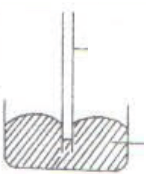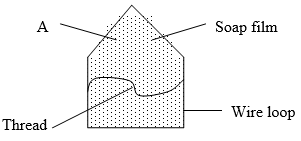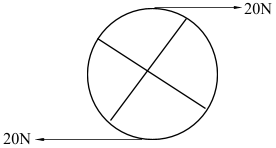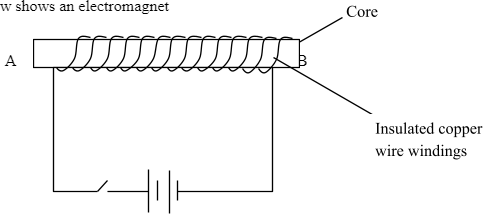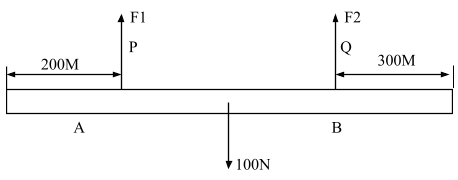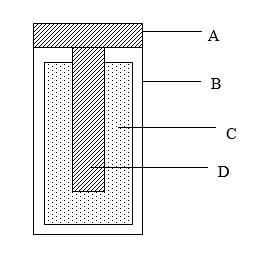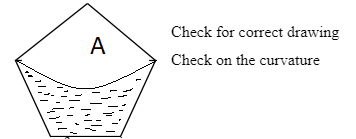PHYSICS
FORM 2
MID TERM
TERM 1
INSTRUCTIONS
- This paper consists of Section A and B
- Answer all the questions
- Show all steps in your calculations
- Take: Acceleration due to gravity g = 10m/s2
- Density of water 1 g/cm3
- Density of mercury 13.6 g/cm3
SECTION A (50 MARKS)
- Draw a vernier caliper scale to show a reading of 3.36cm (2 mks)
- The figure below shows the change in volume of water in a measuring cylinder when an irregular solid is immersed in it.
Given that the mass of the solid is 567g determine the density of the solid in Kg/m3. (Give your answer correct to 2 d.p) (3 mks) - A small drop of oil has a volume of 5 x 10-8m3. When it is put on a surface of some clean water, it forms a circular film of 0.1m2 in area.
- What is the size of a molecule of oil (3 mks)
- State 2 assumptions you made in your calculations (2 mks)
- A body weighs 600N on the surface of the earth and 450N on the surface of another planet. Calculate the value of g in that planet (g on the earth = 10 N/Kg) (3 mks)
- The diagram below shows the behaviour of mercury in a capillary tube. Explain this observation(3 mks)
- How does temperature rise and impurities affect the surface tension of water (2 mks)
- The diagram below shows a soap film trapped in a wire loop with a loose thread passing through
The film is then ruptured at point A- Redraw the diagram to show how the thread is affected (2 mks)
- Explain why the thread behaves in this manner (2 mks)
- The reading on a mercury barometer at Mombasa is 760mm. calculate the pressure at Mombasa (density of mercury = 1.36 x 104 Kg/m3) (3 mks)
- Explain the reason why a person moving from lowland to highland is likely to suffer a hose bleeding (3 mks)
- Describe a simple experiment to show that pressure in liquid increases as depth increases (3 mks)
- Distinguish between the three states of matter in terms of particle spacing and kinetics (3 mks)
- Explain why the blades of a panga feels colder than the wooden handle when touched with a finger after exposure to low temperatures (2 mks)
- The figure below shows a ray of light being incident on a mirror
What is the angle of reflection (3 mks) - The diagram below shows a “couple” in action
Given that the diameter of the wheel is 0.6m, determine the moment to the couple (3 mks) - State the basic law of magnetism (2 mks)
- Draw the magnetic field pattern for the magnets shown below (2 mks)
- Explain the reason why a freely suspended bar magnet comes to rest pointing in the N – S direction
(3 mks) - Explain why repulsion is the only sure test for magnetism (2 mks)
SECTION B (50 MARKS)
- The figure below shows an electromagnet
- Explain why the core is made up of iron and not steel (2 mks)
- On the same diagram indicate the direction of the current flow when the switch is closed (1 mk)
- When the current is allowed to flow through the electromagnet it is magnetized. Identify the poles of the magnet (2 mks)
- Give the name of the law you have used to determine the poles and state it (3 mks)
- Explain what would happen if the current is allowed to flow for a long time (2 mks)
- Brownian motion of smoke partides can be studied by using the apparatus shown below. To observe the motion, some smoke is enclosed in the smoke cell and then observed through the microscope as shown below
- Explain the role of the smoke particles, lens and microscope in the experiment (6 mks)
- State and explain the nature of the observed motion of the smoke particles (3 mks)
- State what will be observed about the motion of the smoke particles if the temperature surrounding the smoke cell is raised slightly (1 mk)
-
- State the principle of moments (2 mks)
- The diagram below shows a uniform wooden beam of length 6m and mass 30kg pivoted as shown below
How far from the pivot will the 65kg mass be for the beam to be in equilibrium (3 mks) - A uniform metre rule of weight 100N is suspended horizontally by two vertical springs P and Q placed 20cm and 30cm from its ends respectively. Calculate the force (tension) in each string(5 mks)
- In an experiment to determine the density of a soil using a density bottle, the following measurements were recorded.
Mass of empty density bottle = 42. 9g
Mass of density bottle full of water = 66.1gMass of density bottle with some soil = 67. 2g
Mass of density bottle with soil filled up with water = 82.0g
Use the above data to determine the:-- Mass of water that completely filled the bottle (2 mks)
- Volume of water that completely filled the bottle (1 mk)
- Volume of the density bottle (1 mk)
- Mass of soil (1 mk)
- Mass of water that filled the space above soil (1 mk)
- Volume of soil (1 mk)
- The density of the soils (2 mks)
- The figure below shows the features of a dry cell (lenclanche). Use the information in the figure to answer the following questions.
- Name the parts (4 mks)
- Explain the purpose of B (2 mks)
- State 2 defects of a dry cell and give their remedies (4 mks)
- Name the parts (4 mks)
MARKING SCHEME
SECTION A (50 MARKS)
- Draw a vernier caliper scale to show a reading of 3.36cm (2 mks)
Check for correct drawing
Main scale 3.3 √
Vernier scale 0.06 √ - The figure below shows the change in volume of water in a measuring cylinder when an irregular solid is immersed in it.
Given that the mass of the solid is 567g determine the density of the solid in Kg/m3. (Give your answer correct to 2 d.p) (3 mks)
Volume of water displaced = 100 – 60 = 40cm3
Volume of water displaced = Vol. of stone = 40cm3 √
P=MV(do not award a mark for the formula)
P=567g/40cm3=14.175g/cm3(correct substitution) √
P=14.18g/cm3(Answer must be given correct to 2d.p) - A small drop of oil has a volume of 5 x 10-8m3. When it is put on a surface of some clean water, it forms a circular film of 0.1m2 in area.
- What is the size of a molecule of oil (3 mks)
Volume of drop = 5 x 10-8 M3
Area of circular film = 0.1M2
V = A x H
h=VA √
Size of molecule=5 x 10-8m/20.1m2
=5.0 x 10-7m √
Accept 0.0000005
Check for correct units. - State 2 assumptions you made in your calculations (2 mks)
Atoms are spherical √
Mass uniformly distributes √
- What is the size of a molecule of oil (3 mks)
- A body weighs 600N on the surface of the earth and 450N on the surface of another planet. Calculate the value of g in that planet (g on the earth = 10 N/Kg) (3 mks)
Weight on Earth = 600N
Weight on Planet = 450N
Weight, W = Mg
M=Wg
Mass of body=600N/10N/Kg=60Kg √
g=wm
g=450N/60Kg=7.5N/Kg√
Correct substitution √
Correct answer with correct units √ - The diagram below shows the behaviour of mercury in a capillary tube. Explain this observation(3 mks)
The force of cohesion within the mercury is greater than the force of adhesion between mercury and glass √.
The mercury therefore sinks down √the tube to enable mercury molecules to keep together√. - How does temperature rise and impurities affect the surface tension of water (2 mks)
Temperature rise and impurities lower the surface tension of water √ - The diagram below shows a soap film trapped in a wire loop with a loose thread passing through
The film is then ruptured at point A- Redraw the diagram to show how the thread is affected (2 mks)
- Explain why the thread behaves in this manner (2 mks)
The unbalanced √ surface tension√ pulls the thread tight
Check for correct drawing √
Check on the curvature √
- Redraw the diagram to show how the thread is affected (2 mks)
- The reading on a mercury barometer at Mombasa is 760mm. calculate the pressure at Mombasa (density of mercury = 1.36 x 104 Kg/m3) (3 mks)
h = 760mm
p = 1.36 x 104 Kg/m3
p = ?
p = pgh
p=1.36 x 104 x 10 x 7601000
Check on the conversion √
Correct substitution √
P = 103,360 N/M2
Accept P = 103,360 pa √ check for correct units - Explain the reason why a person moving from lowland to highland is likely to suffer a nose bleeding (3 mks)
The external pressure (atmospheric) is lower than the internal pressure √: therefore the capillaries break √. - Describe a simple experiment to show that pressure in liquid increases as depth increases (3 mks)
The bottle with hole experiment – if diagram used; check for labeling√: Procedure, observation and conclusion√.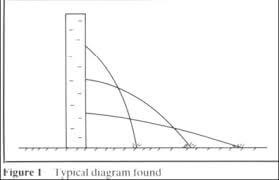
- Distinguish between the three states of matter in terms of particle spacing and kinetics (3 mks)
Solid – particles very close, hence low kinetic energy√.
Liquids – particles fairly free, moderate kinetic energy √
Gases – particles very free, high kinetic energy √ - Explain why the blades of a panga feels colder than the wooden handle when touched with a finger after exposure to low temperatures (2 mks)
The metal blade conducts heat from the hand but the wood cannot √ - The figure below shows a ray of light being incident on a mirror
What is the angle of reflection (3 mks) - The diagram below shows a “couple” in action
Given that the diameter of the wheel is 0.6m, determine the moment to the couple (3 mks)
√
Check for correct units - State the basic law of magnetism (2 mks)
Unlike poles attract while like poles repel√
Reject – unlike charges attract while like charges attract
Reject – unlike terms attract while like terms attract - Draw the magnetic field pattern for the magnets shown below (2 mks)
Check for direction of field √
Check for presence of the neutral zone√ - Explain the reason why a freely suspended bar magnet comes to rest pointing in the N – S direction
(3 mks)
This is due to the influence of the Earth’s magnetic field√ - Explain why repulsion is the only sure test for magnetism (2 mks)
Repulsion only occurs between 2 like poles√ but attraction may occur between 2 unlike poles or between a magnet and a magnetic materials√
SECTION B (50 MARKS)
- The figure below shows an electromagnet
- Explain why the core is made up of iron and not steel (2 mks)
Iron is a soft magnetic material it can easily acquire magnetism and can easily lose magnetism. - On the same diagram indicate the direction of the current flow when the switch is closed (1 mk)
- When the current is allowed to flow through the electromagnet it is magnetized. Identify the poles of the magnet (2 mks)
A – North pole√
B – South pole √ - Give the name of the law you have used to determine the poles and state it (3 mks)
Right hard grip rule√
It states that if a coil carrying current is grasped in the right hand such that the fingers point in the direction of current then the thumb points in the direction of North Pole√. - Explain what would happen if the current is allowed to flow for a long time (2 mks)
It would cause overheating on the electromagnet√. This adversely affects the magnetism of the electromagnet√.
- Explain why the core is made up of iron and not steel (2 mks)
- Brownian motion of smoke particles can be studied by using the apparatus shown below. To observe the motion, some smoke is enclosed in the smoke cell and then observed through the microscope as shown below
- Explain the role of the smoke particles, lens and microscope in the experiment (6 mks)
Smoke particles – smoke particles are larger than air molecules and light enough to move when bombarded by air molecules √
Lens – focuses the light from the lamp on the smoke particles, causing them to be observable
Microscope – enlarges/magnifies the smoke particles so that they are visible √ - State and explain the nature of the observed motion of the smoke particles (3 mks)
Smoke particles more randomly/zigzag √
Air molecules bombard the smoke particles
Air molecules are in random motion - State what will be observed about the motion of the smoke particles if the temperature surrounding the smoke cell is raised slightly (1 mk)
The speed of motion of smoke particles will be observed to be lighter/faster/speed increases√.
- Explain the role of the smoke particles, lens and microscope in the experiment (6 mks)
-
- State the principle of moments (2 mks)
Principle of moments states that for a system in equillibrium, the sum of clockwise moments must be equal to the sum of the anticlockwise moments. - The diagram below shows a uniform wooden beam of length 6m and mass 30kg pivoted as shown below
How far from the pivot will the 65kg mass be for the beam to be in equilibrium (3 mks) - A uniform metre rule of weight 100N is suspended horizontally by two vertical springs P and Q placed 20cm and 30cm from its ends respectively. Calculate the force (tension) in each string(5 mks)
Answer:
Clockwise moments = Anticlockwise moments
- State the principle of moments (2 mks)
- In an experiment to determine the density of a soil using a density bottle, the following measurements were recorded.
Mass of empty density bottle = 42. 9g
Mass of density bottle full of water = 66.1gMass of density bottle with some soil = 67. 2g
Mass of density bottle with soil filled up with water = 82.0g
Use the above data to determine the:-- Mass of water that completely filled the bottle (2 mks)
66.1-42.9=23.2g - Volume of water that completely filled the bottle (1 mk)
Volume=Mass/density=23.2cm3 - Volume of the density bottle (1 mk)
Volume of denity of bottle=volume of water=23.2cm3 - Mass of soil (1 mk)
67.2 -42.9=24.3g - Mass of water that filled the space above soil (1 mk)
82.0-67.2
14.8g - Volume of soil (1 mk)
volume of water =14.8cm3
23.2-14.8=8.4cm3 - The density of the soils (2 mks)
Mass/Volume
24.3/8.4√
= 2.893g/cm3√
- Mass of water that completely filled the bottle (2 mks)
- The figure below shows the features of a dry cell (lenclanche). Use the information in the figure to answer the following questions.
- Name the parts (4 mks)
- - Seal and insulator√
- – Zinc case√
- – Mixture of carbon and manganese (IV) oxide√
- – Carbon rod √
- Explain the purpose of B (2 mks)
Zinc case acts as a negative electrode√ - State 2 defects of a dry cell and give their remedies (4 mks)
- Polarisation√
Remedy – Adding a depolarizer e.g potassium dichromate√ - Local action√
Remedy – By amalgamation√
Accept – use of pure zinc or coating zinc with mercury √
- Polarisation√
- Name the parts (4 mks)
Download Physics Questions and Answers - Form 2 Term 1 Mid Term Exams.
Tap Here to Download for 50/-
Get on WhatsApp for 50/-
Why download?
- ✔ To read offline at any time.
- ✔ To Print at your convenience
- ✔ Share Easily with Friends / Students


